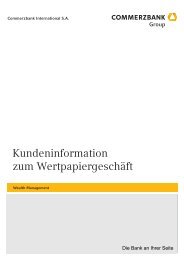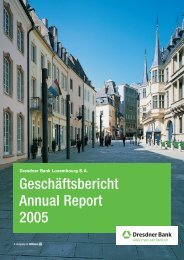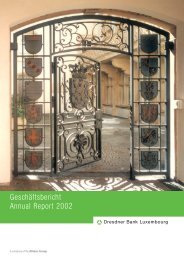Dresdner Bank - Commerzbank International SA
Dresdner Bank - Commerzbank International SA
Dresdner Bank - Commerzbank International SA
You also want an ePaper? Increase the reach of your titles
YUMPU automatically turns print PDFs into web optimized ePapers that Google loves.
The risk management process of the bank takes place in close cooperation with the units of the <strong>Dresdner</strong><br />
<strong>Bank</strong> Group. The general conditions defined by the <strong>Dresdner</strong> <strong>Bank</strong> Group specifically apply. In the Group,<br />
an extensive risk management and controlling system is established, which guarantee consistent management<br />
of the risks across the units. The rules and standards of the <strong>Dresdner</strong> <strong>Bank</strong> Group are at the level<br />
of the bank and are adapted/expanded to accommodate local requirements on the basis of its business<br />
model.<br />
The risk appetite of the bank is expressed through the minimum relationship between internally calculated<br />
risk capital for covering existing risks and the risk-bearing capacity, mainly the liable equity capital of<br />
the bank. With the calculation of the internal risk capital, the <strong>Dresdner</strong> <strong>Bank</strong> Group approaches are relied<br />
upon. The bank's Supervisory Board and Management Board define the minimum thresholds for solvency<br />
coefficients. In doing so, internal risk capital is compared under normal conditions, as well as under stress<br />
conditions of risk-bearing capacity.<br />
The bank’s risk profile is reviewed on a regular basis. As far as it is meaningfully possible, all material risks<br />
are quantified. Individual risk types, particularly reputational risks, are encountered with proactive management<br />
and sensitisation of the employees, instead of quantification.<br />
Market risks<br />
Market risks are understood as possible fluctuations in the value of a portfolio as a result of changes in<br />
market prices, such as interest rates, share prices or exchange rates. Market risks for <strong>Dresdner</strong> <strong>Bank</strong><br />
Luxembourg S.A. are assessed according to group-wide standards using the parametric value at risk<br />
method (VaR).<br />
Risk calculation and limitation follows the <strong>Dresdner</strong> <strong>Bank</strong> Group’s internal model based on a 1-day holding<br />
period and a 95% confidence level. For the overall bank, a limit exists, which was utilised in the<br />
amount of € 2.15 million through continuing market volatilities. In addition to the VaR calculation, the<br />
effects of extreme market trends, such as the simulation of a 200 basis point interest rate rise, on the<br />
portfolio’s value are observed in the context of stress testing.<br />
Liquidity risks<br />
Liquidity risk is the risk of not being able to meet current and future payment obligations either fully or at<br />
the due time, or, in the event of a liquidity crisis, the risk involves refinancing that can be generated only<br />
at excessively high market rates (refinancing risk) or assets that can be liquidated only with discounts on<br />
market prices (market liquidity risk).<br />
At the <strong>Dresdner</strong> <strong>Bank</strong> Group, liquidity risks are assessed on the basis of an integrated system, which indicates<br />
the maturity structure for all future cash flows and generates a cash flow balance sheet, taking into<br />
consideration available first-class collateral. Risks are limited respectively in the context of a structured<br />
limit system. Regular stress testing shows the effects on liquidity in different extreme scenarios.<br />
Notes to the Annual Accounts<br />
63<br />
Balance Sheet as at 31 December 2008






